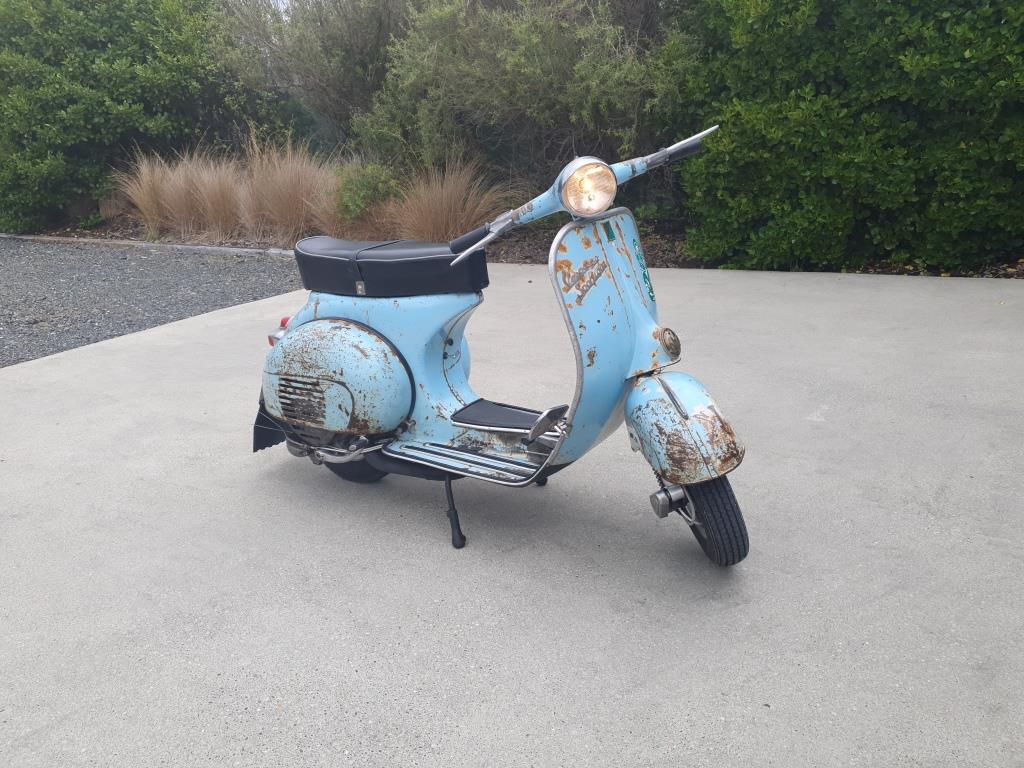1962 Sportique update 2
Most of my scooters have 10″wheels and have been modified in some way for suspension or engine upgrades. I have ridden 8″ scooters before but never spent a lot of time riding them and until now tended to stick to bigger wheels with better tyres and brakes.
The Sportique 150cc engine isn’t very powerful and a stock one may eventually get to 70kph. Combined with average brakes and the limited ground clearance that small wheels provide this isn’t necessarily a bad thing. They were designed to be virtually bullet proof and if maintained properly, would run for years. This one still ran a couple of years ago so 60 something years is testament to the design of these scooters.
The new DR177 engine starts and runs very well. I like to spend the time and run in these cast iron cylinders and get a basic tune which allows the engine to operate properly. The DR manufacturer recommends 18 degrees for timing on these cylinders and the original 20/17C carburetor has been upgraded to a 20/20D. Most 177 engines with a decent exhaust can run quite happily with a 24mm carb giving more horsepower, however your options are limited with the available ground clearance for a good exhaust.
I have been running Polini box exhausts on most of my scooters for some time now and have found them to be very good. They can interfere with the centre stand but that’s pretty normal for a lot of aftermarket Vespa exhausts. This Polini exhaust looks and sounds like the standard vespa type box exhausts of old with the longer tail pipe.
My experience with the Dellorto SI 20mm carburetors has been limited to be fair so finding the right jetting for this engine/exhaust combination has been a work in progress. The factory settings for the original 20/17C carb are:
- Choke – 60
- Atomisor – E1
- Air Corrector – 140
- Pilot – 42
- Main – 100
Compared to a 24/24E carb from a Rally / PX200:
- Choke – 60
- Atomisor – BE3
- Air Corrector – 160
- Pilot – 50/55
- Main – 112/118
While the engine is still being run in the 24mm carb isn’t in the picture at the moment so the 20mm was a better option for now, as I had a couple in my cack stash. I have finally found a combination that seems to be nearly spot on:
- Choke – 60
- Atomisor – BE3
- Air Corrector – 160
- Pilot – 55
- Main – 104
- Idle screw – 1.75 turns out
- Mixture screw – 1.5 turns out
After some plug chops the main was a little lean so I changed it from a 100 to a 104. Just for fun I put a 116 main in there but that was just terrible and the scooter could hardly run and hated it. I like to run NGK B8ES plugs on most of my modified scooters but an NGK B7 would work just as well. The engine starts second kick with choke and makes good power (although not thrashing it at the moment) and sounds great with the new exhaust.
The little scooter is fun to ride and is a step back to a time where things were well designed and manufactured. New suspension and a decent seat make a real difference however traffic roundabouts and speed humps need to be treated with respect. I had some older radial tyres in excellent condition and with new tubes they seem to be pretty good – I probably wouldn’t take it around Teretonga though. After replacing just about everything that can be replaced, I was very surprised to find the original speedometer still works and is still reasonably accurate. The numbers are pretty faded and the glass is scratched but that just goes with the rest of this scooter.
It may be for sale at some stage so get in touch if you are interested.
1962 Sportique update 2
